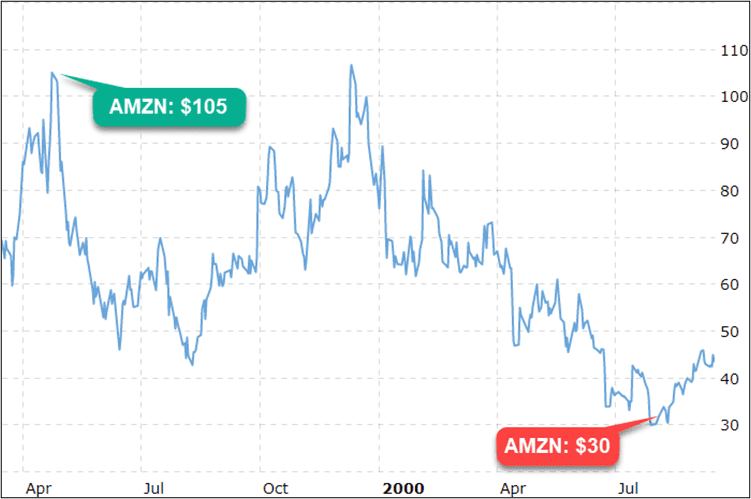Start Investing Today
Did you know the average APY (Annual Percent Yield or interest) on a savings account is a putrid .06%? That means, if you put $10,000 into a savings account on Jan 1, you would have $10,060 at the end of the year. That should be enough to cover your gas when you drive to the bank to pull your money out of the savings account on Dec 31. If you ever wanted to start investing, yesterday would be the time.
I have nothing against savings accounts but what if you took that $10,000 and earned a compounding 5% on an investment portfolio as well as a 2% dividend payout each year. You would have $13,762 at the end of 5 years; $3k more than if you left that money in that savings account. Easier said than done? With the right approach to building a stock portfolio, these results can become a reality.
Basic Rules for Investing in the Stock Market
Buy Your First Stock with Disposable Income
There is no greater way to learn how to invest than to actually get some skin in the game and become an active investor in the stock market. However, as tempting as it is to dive headfirst into the stock market, quit your day job to become a day trader on an island in the Pacific, you need to use caution when purchasing your first stock and building your beginner portfolio.
Purchase your first stock with disposable income. Do not carve out investment income by taking money out of your monthly budget essentials. This would include, healthcare, home, auto, childcare, etc. However, if you are looking to carve out some income to invest, check your expendable line items in your monthly budget such as entertainment, alcohol, jewelry, etc.
Once you have this income carved out, don’t expect to invest $1,000 dollars and double it by the end of the day. Take your time and ensure you are taking the proper steps to scale to a smart and manageable investment. It takes time and education to become a smart investor but if you take the right steps, you can create an outstanding return for yourself.
Find a Broker You Know and Trust
The first thing you should ask yourself when creating your first investment portfolio is, “Do I have the time to give my investments the attention they need and deserve?” This is often a difficult question to answer because life is filled with other priorities and learning the right way to invest does indeed take time. It often starts with the basics, including educating yourself to how the stock market works and the different ways you could invest your money.
If you still want to invest but don’t have time, finding a broker that can manage your portfolio for you can be an outstanding option. There are excellent fiduciaries and financial advisors that can create a personalized portfolio for you that can grow your wealth. This is called a “Managed Portfolio.”
Pros of a Managed Portfolio:
- Frees up your time
- Probably more lucrative than a savings account
Cons of a Managed Portfolio:
- Loss of financial independence
- Lack of ownership of your financial livelihood
- Costly management costs and commission fees
However, if you want to take a greater role in managing your wealth and carving out your own path to financial freedom, creating a “Self-Directed Portfolio” has never been easier. With the rise of incredibly efficient and sophisticated technology, online investment apps or brokers have made becoming a savvy retail investor more of a reality than it ever has been.
Build a Self-Directed Investing Portfolio
Self-Directed investing is when you manage all the money and decisions in your investing portfolio. A managed portfolio is when you have a money manager or Registered Investment Advisor (RIA) manage your investment portfolio for you.
There are pros and cons to both approaches and it really comes down to what you are most comfortable with. There are certainly great RIA’s and money managers out there that could provide great returns but a hands-on approach to investing, gives you a path to financial independence and literacy that a manger would not.
Pros of a Self-Directed Portfolio:
- Become financially literate through investing
- Avoid costly fees and commissions
- Flexibility to buy and sell what and when you want to rather than be tied into a mutual fund
- Great apps and platforms allow you a user-friendly path to investing
Cons of a Self-Directed Portfolio:
- Steep learning curve if you are just starting out (that’s why we’re here)
- A lot of time and effort to create a successful portfolio
- Most likely some early losses as you learn your risk tolerance and investing style
A good approach for new investors is trying a combination of both. Perhaps you have a 401k that you are happy to let a money manager run for you but starting a small, self-directed portfolio at your own pace can provide you the learnings you need to eventually run your entire portfolio.
Stand on the Shoulders of Giants
Creating your own investment portfolio is the easy part. Filling it with quality stocks that make you money over a long period of time is more difficult. You could drive yourself crazy trying to find the one quality stock in which to invest your first dollar.
There are outstanding investment strategies you can leverage to home in on a quality stock pick. A technical or fundamental analysis, growth or value stocks, and even options trading can be leveraged in a stock selection strategy.
But, if you are looking to make the smart investment and build your first portfolio with a solid foundation of winning stocks, then you need to stand on the shoulders of giants. In other words, use the accumulated intellectual knowledge from the top investors who have been doing this for decades to find great stock picks.
There are excellent resources out there that provide outstanding stock advice in the form of online newsletters, websites, podcasts and apps. Any seasoned investor will have a great track-record, resume, consistent strategy and meaningful way to communicate their picks.
A few things to keep an eye out when selecting a stock advice resource – Prices that are way too expensive, no free trials and no refunds available are huge red flags. Investment resources that don’t provide you an easy out are most likely just a flash in the pan, trying to make a quick buck and then get out. They don’t really care if you make money or become a better investor. More than likely, they are trying to sell you a story through a promotion without a real product that would be consistently useful over time.
The Stock Market is the greatest wealth creator in the world. If you have the means, time, and dedication, achieving financial independence through investing is absolutely more than attainable and everyone should strive to do so. So, if it feels like an advertiser is using fear or greed in their sales pitch, take a note of caution. No one should be scared into doing something – especially when it comes to their financial livelihood.
Try Not to be Emotional when You Start Investing
Trying not to be emotional when it comes to investing is like telling my 4-year-old son not to spit toothpaste all over the counter when brushing his teeth. He has the best of intentions going in, but you can believe that once he gets that mouthful of toothpaste, it’s headed for the mirror and not the sink.
This is the same way with investing. This is your hard-earned money. It is tied to your tireless effort at work and often a culmination of sacrifice, headaches, and stress. So, of course you are going to have emotional reactions watching your money fluctuate in the stock market.
Remember this guy? I can guarantee you with near certainty that almost every investor has had this experience before.

A recent Nobel-prize study by prominent psychologist, Daniel Kahneman, examined the concept of loss vs. gain and the emotional reactions. The study concluded that the pain of a loss is felt twice as intense as the pleasure from a gain. Let’s say you bought $5,000 worth of Amazon stock in 1999 for $105 dollars per share. That would be awesome, right? Well, it wouldn’t be if you let your emotions dictate your investment strategy.

Every investor must learn through experience and for new investors, there is a lot of trial by fire. But if you can have the right expectations going into investing and take the right measures to protect yourself, you will set yourself up for a successful run.
Start Investing with Strong Portfolio Diversification
Portfolio Diversification: Diversification in investing is important because not all markets are created equal and diversified stocks will react differently to different market events.
Poor Diversification: All your Assets are imbalanced into one stock, bond, sector, commodity, or fund.
In the first half of 2020, tech stocks saw a meteoric performance. The natural inclination of individual investor would be to pour their assets into the tech sector to capitalize on this trend.
Now, let’s say millions of investors have the same idea and allocate all of their assets into tech over a long period of time. At some point, tech stock prices will become inflated due to the enthusiastic market behavior and not the underlying fundamentals of a stock. And now you have a bubble.
And all it takes is one instance of socio-economic turmoil, like a new trade war or the stock’s price becomes too high and a massive sell-off ensues, popping this bubble and sending this sector to the ground.
If all of your assets are in the tech sector during this time, you are going to be S.O.L.
Proper Diversification: All your assets are balanced into uncorrelated holdings or sectors protecting you from major down-turns in any one investment.
The only thing that is certain these days, is uncertainty. This holds particularly true for the stock market. The world is volatile, and the market is volatile. However, not all areas of the market are volatile at the same time. In fact, there saying goes, “There is a bull market somewhere.”
An example of this is stocks vs. bonds. If the market performs well, stock go up and bonds go down. If the market performs poorly, bonds go up and stocks go down. Having a good balance of both stocks and bonds can protect you from any poor performing sector.
Let’s take a look at a properly diversified portfolio:
| Investment | Allocation |
| U.S. Stocks | 40% |
| Foreign Stocks | 15% |
| Real Estate | 20% |
| U.S. Bonds | 25% |
| Total | 100% |
The important thing to notice about this diversification is that none of these investments are correlated to each other. If a catastrophe occurs in the real estate market, only 20% of your total investments are in there, so you have protected your downside.
Further diversification can occur within stocks themselves at a sector level. Companies make up vastly different industries which are classified into 11 different sectors. Diversifying your investments into different sectors can further balance your portfolio. Here is an example of the diversification of the U.S. Stock Investments.
| U.S Stock Investment | Allocation |
| Technology | 40% |
| Healthcare | 15% |
| Precious Metals | 20% |
| Consumer Goods | 25% |
| Total | 100% |
Proper diversification is a building block to a successful portfolio. Ensuring you are taking low risk as you build your portfolio is just as important.
Start Investing with These Investment Strategies for Beginners
Invest in Quality. Easier said than done? There is a simple formula that identifies whether a stock is quality or not. I like to call it my Top>Down approach to finding a great stock strategy,
- Find the Sector Leader: Which sector is leading the way right now? Is tech hot or has energy led the way in the markets
- Find the Market Leader: Which stock is the market leader in that sector? Who is the largest, most profitable in the sector? Who has the best consumer sentiment and brand recognition right now? That’s how you find your Market Leader
- Find the Consistent Track Record: Your first stock selection should have a track record of at least 5-10 years. Look at the performance of this company as a relation of other companies within the same sector. Did this company outperform its competitors in times of growth? Was it able to avoid major financial dips during periods of correction?
The Dividend Growth Rate: We love Dividends at Wealthplicity and a solid Dividend Growth rate is a great indicator of a high performing stock. The dividend growth rate is the annualized percentage rate of growth that a stock realizes over a period of time. If a company increases is dividend on an annual basis, could indicate future dividend growth and longer-term profitability
ETF’s Are a Great Way to Start Investing
ETF’s, or Exchange Traded Funds, can be an excellent opportunity for those investors looking for moderate growth over a longer period of time. ETF’s are just like index mutual funds, except you can buy and sell these at any time during normal trading hours. Regular mutual funds can only be traded after closing prices are reported.
ETF’s allow individual investors to own shares of popular stocks without paying a premium price. For example, the Consumer Discretionary Select Sector SPDR Fund (XLY) currently trades at around $150 per share. This fund contains major, blue chip stocks such as Amazon (AMZN), Home Depot (HD) and McDonalds (MCD). These stocks actually make up 43% of the total holding allocation. If you bought 10 shares of XLY, it would cost you around $1,500. However, if you bought 10 shares of Amazon, it would cost you $30,000. Home Depot would cost you around $2s800 and McDonalds would cost you around $2,150.
With an ETF strategy, you now get to own shares of these stocks through this fund without having to put all of your eggs in one basket or paying a premium for individual stocks.
There are now close to 7,000 ETF’s, so deciding the right one to purchase can be daunting. Fortunately, we rank the top performing ETF’s here so making your financial investment decisions can be easy, not overwhelming.
We visit a lot of different investing strategies here at Wealthplicity. We take a deeper look in our “Many Ways to Invest Strategy” since understanding what strategy works for you is a cornerstone to great investing. But for the Investing for Beginners crowd, taking the right steps before diving in, can you save, and earn you a lot of return on your investments.




